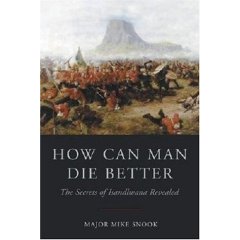Isandlwana - Rorke's Drift Reconsidered


How Can Man Die Better: The Secrets of Islandlwana Revealed by Major Mike Snook-- Wednesday 22 January 1879 was one of the most dramatic days in the long and distinguished history of the British Army. At noon a massive Zulu host attacked the 24th Regiment in its encampment at the foot of the mountain of Isandlwana, a distinctive feature that bore an eerie resemblance to the Sphinx badge of the outnumbered redcoats. Disaster ensued. Later that afternoon the victorious Zulus would strike the tiny British garrison at Rorke's Drift. How Can Man Die Better is a unique analysis of Isandlwana, of the weapons, tactics, ground, and the intriguing characters who made the key military decisions. Because the fatal loss was so high on the British side there is still much that is unknown about the battle until now. Mike Snook is the first military professional to scrutinize the battle in print since 1879. He has an unparalleled grasp of the nuances of the ground at Isandlwana and of their implications in practical military terms. Most compellingly he has an instinctive feel for the characters who forged this supremely dramatic history, for this is family history, the battle was fought by soldiers of the author's own regiment. This is a work of unparalleled depth, which eschews the commonly held perception that the British collapse was sudden and that the 24th Regiment was quickly overwhelmed. Rather, there was a protracted and heroic defence against a determined and equally heroic foe. The author reconstructs the final phase of the battle in a way that has never been attempted before. It was to become the stuff of legend, which the author brings to life so vividly that one can almost sense the fear and smell the blood. How Can Man Die Better is essential reading for anyone interested in Isandlwana, the wider Anglo-Zulu War or the Victorian Army.
Like Wolves on the Fold: The Defense of Rorke's Drift by Major Mike Snook --
Wednesday 22 January 1879 was one of the most dramatic days in the annals of military history. In the morning, a modern British army was swept aside by the onset of a seemingly unstoppable Zulu host at Isandlwana. Nearby, at a remote border outpost on the Buffalo River, a single company of the 24th Regiment and a few dozen recuperating hospital patients were passing another hot, monotonous day. News of the disaster across the river came like a bolt from the blue. Retreat was not an option. It seemed certain that the Rorke's Drift detachment would share the terrible fate of their comrades. Following on from How Can Man Die Better, Colonel Snook brings the insights of a military professional to bear in this strikingly original account. It is an extraordinary tale a victory largely achieved by the sheer bloody-mindedness in adversity of the British infantryman, fighting at the remarkable odds of over thirty to one. The heroics of all eleven VC winners are recounted in detail, and we are offered new insights into how the Zulu attack unfolded and how 150 men achieved their improbable victory. The author describes the remainder of the war, from the recovery of the lost Queen's Colour of the 24th to the climactic charge of the 17th Lancers at Ulundi. We return to Isandlwana to consider culpability, and learn of the often tragic fates of many of the war's participants. Like Wolves is a remarkable work, and the author's unbridled respect for the fighting qualities of British soldier and his abiding affection for the Zulu people shines through.
<< Home